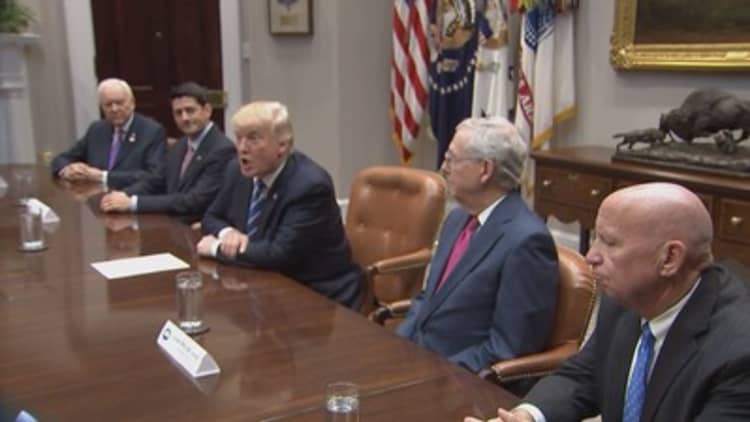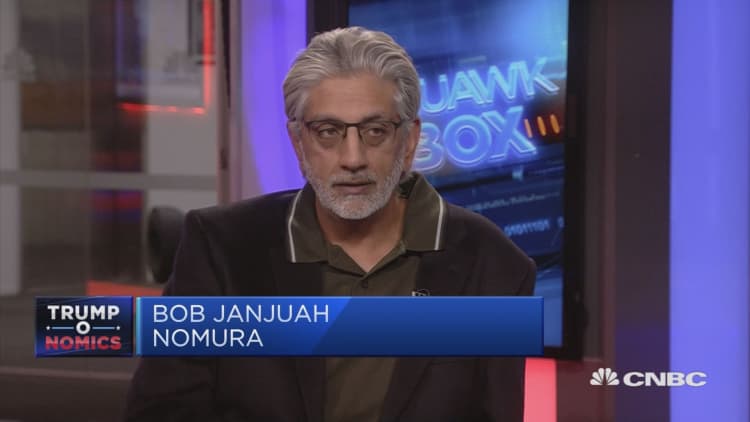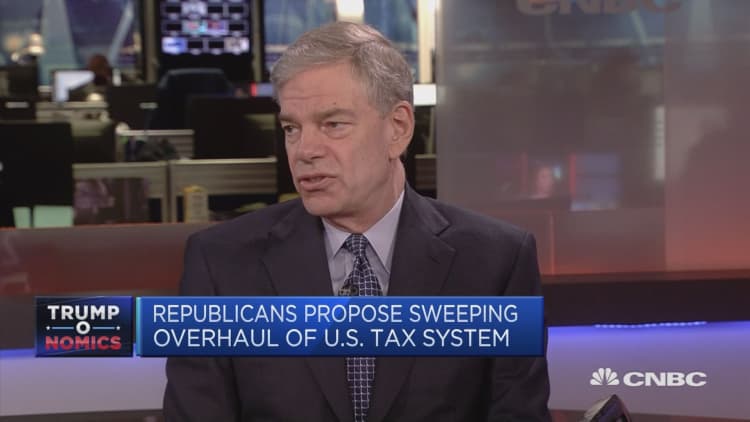
Economists at the Royal Bank of Canada gave an optimistic take on tax reform plans unveiled in the U.S., suggesting in its current form it will boost growth and urge investors to rethink the stock markets.
"Acknowledging that some key details are still missing, a good baseline is that this tax plan could increase GDP (gross domestic product) growth by at least 0.5 percent per year," senior U.S. economists Tom Porcelli and Jacob Oubina at RBC Capital Markets, and Michael Cloherty, head of U.S. rates strategy at the firm, said in a note on Wednesday evening.
"We think the fact that tax cuts are coming at the mature stage of the cycle and not in a typical post-recession means the 'propensity to spend' could very well be higher than historically observed … Over a decade, the level of GDP could be 5 percent higher than a baseline forecast," they added.
By implementing tax cuts, the U.S. Treasury Department could be facing a "static cost around the $2.0 trillion zone," they said. The Treasury could be forced to borrow more, potentially increasing the deficit at a time of already high borrowing and rising interest rates, they added. RBC also predicts that the Federal Reserve could be forced to rate hikes at a quicker pace due to the "firmer GDP, lower unemployment, firmer inflation."
RBC estimates that slashing taxes could add an average $10.50 to an S&P 500 company's earnings per share (EPS) over one year. Earnings per share is an important metric used by stock traders to indicate a company's profitability. Thus adding an additional 200 points to the S&P.
"This is a direct flow-through to the bottom line. We'd also have to consider any impact from increased buybacks from not only a lower corporate rate but from repatriation flows. Moreover, we'd have to consider the positive knock-ons to topline growth from a firmer GDP profile on the back of the individual tax reductions," they said. Buybacks occur when firms purchase their own shares, reducing the proportion in the hands of investors. Like dividend payments, buybacks offer a way to return cash to shareholders and usually see a company's stock push higher as shares get scarcer.
The proposal
On Wednesday, a preliminary "framework" of tax reforms was released by Republican leaders, highlighting a simplification of the tax code and key tax cuts for individuals and businesses. Although many details were left out of the preliminary framework for tax reform, the key highlights included plans to simplify the tax code, reduce the amount of basic income tax rates from seven to three (although the income level at which each rate of tax would kick in was omitted) as well as tax breaks for individuals and businesses, outlining plans to cut the corporate tax rate to 20 percent.
The framework was more notable for what it omitted, however, with popular tax deductions – such as the tax breaks for mortgage interest, charitable donations or medical expenses – missing from the proposals.
While the framework included tax cuts, it is expected that the government will try to make up the shortfall by closing various other tax breaks — deductions, exemptions and exclusions that cost the government nearly $1.4 trillion in fiscal 2017, according to the Treasury – moves which could prove tricky to agree.
Caveats
Saying that there was "no politics on our part here," the RBC economists said their analysis was based on "the math behind the plan that presently exists."
"Whether or not this actually comes to fruition is a totally different question. As we said, there are many assumptions built into this and perhaps more important, there is simply no way to know what the final proposal will look like. And its ability to pass is another unknowable at this point."
"You will serve yourself well to remember that U.S. economic fundamentals remain exceedingly sound and even without these tax cuts, it is easy to hold a constructive view on US growth over the balance of the year and into 2018," they said.

Fiscal hope?
Meanwhile, Bob Janjuah, senior independent client advisor at Nomura Instinet, told CNBC Thursday that the proposals were "potentially a very important plan" but cautioned that the actual end package of reforms could be far less dramatic.
"Of course, with everything that we've seen with this presidency, the initial headlines can be up in the skies and what actually gets delivered can be the opposite, so we'll see. For me, the interesting thing is that the markets shouldn't forget is that the cost of capital – courtesy of the Fed, B)E (Bank of England) etc – is going to go up. So the issue now how much do we price in fiscal hope and how do we cope with an increasing cost of capital?"

Globality Chief Executive Joel Hyatt added that what Trump had proposed was not a "well-constructed tax reform" and echoed criticisms from Democrats that the tax reforms mainly served the wealthy.
"I (also) don't believe it will get enacted in the format that he's talking about. I think we need to rationalize corporate taxation and I think that that will include lowering it. But this is a tax package that couldn't be called reform, it's heavily, heavily weighted towards the wealthy and eliminates some fundamentals of American taxation principles," he said.
Correction: This story was revised to correct that the tax plan was unveiled by Republican leaders.


